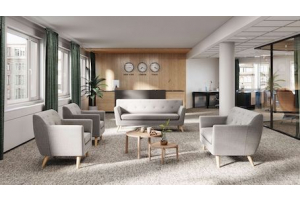Should My Desk Face the Window? Increase Productivity
Facing a window during the working day can feel refreshing, and a touch of people-watching can provide welcome entertainment during long Zoom calls. However, the heat and glare of harsh sunlight often outweigh these positives. The answer? Place your desk at an angle to get the best of both worlds.
Benefits of placing your desk directly in front of a window
It goes without saying that no one wants to be staring at a blank, grey wall all day, and positioning your desk in such a way can leave your working space feeling like a prison cell. These last two years, we have all experienced feelings of claustrophobia and the last thing we want to do is amplify that for 8 hours of the day.
By placing your desk directly in front of a window, you may feel some benefits. Perhaps a spot of bird watching can provide a welcome short break for your brain between challenging tasks. Maybe keeping up with the comings and goings of local dog walkers can provide some inspiration for you to get out there during your lunch break, boosting afternoon productivity.
Of course, the serotonin boost provided by feeling sunlight on your face would not go unnoticed, given the established link between serotonin and improved mental health. Across the world, rates of depression and anxiety have risen during the COVID-19 pandemic, so anything that can be done to boost mood is welcome. Even on cloudy days, a burst of sunshine poking through the grey sky can provide the lift that you need to get through your afternoon meeting.

The importance of taking regular breaks away from screens for your eyes also cannot be downplayed. A window in front of your desk provides ample opportunities to rest your eyes from the harsh artificial light of your display.
Drawbacks to placing your desk directly in front of a window
We’ve spoken about the positives to be gained from an influx of sunlight onto your desk, but what about in the warmer summer months, when this sunlight brings high temperatures with it? Conversely, windows can bring drafts in the colder months. These fluctuations in temperature can have widespread effects.
Studies have shown that temperature has a direct impact on productivity and an uncomfortable temperature can shift your focus from the task at hand for up to half an hour every day. The optimal temperature for tip-top productivity has been found to be somewhere between 21 and 23 degrees Celsius. Setting your thermostat to stick to these temperatures from 9 to 5 may prove useless if the sun and wind from your window disturb this equilibrium.
More worrying, overexposure to heat can cause health complications, including heat exhaustion and heatstroke. Signs of heat exhaustion include headaches, dizziness, confusion, nausea, cramps, quickened breathing and being very thirsty. No one needs these symptoms on top of the stress of a normal workday, so it is important to be mindful of the temperature of your space.
Overheating is not only a problem for you, but also for your electrical equipment. Damage to electronics caused by overheating can be irreversible and the temperature of our devices is a deciding factor in their longevity. In a world where we are becoming increasingly alive to the threats of waste and ever expanding landfills and where disposal of electronic waste can lead to toxic substances contaminating our soil and water; we need our devices to last.
On the other hand, a drafty window creating a cold working environment or unpredictably in temperatures runs the risk of making you more likely to become ill. Aside from the obvious that no one wants to be ill, an illness commonly leads to absences from work and the stress of having to play catch-up on your expenses can be hard to manage.
It’s not only the sun’s temperature that can wreak havoc on your meticulously planned day. Glare caused by the sun can cause eye fatigue and headaches. Staring at screens all day is bad enough, without adding to this with consistent direct sunlight when our eyes should be having a much needed break.
Difficult lighting can also make Zoom calls more challenging. We’ve all been on a call with someone (or been that someone) and their face is entirely obscured by bright white light or they’re a shadowy figure cast into darkness by bright light behind them. Virtual meetings present enough obstacles to authentic interactions in the business world without bad lighting adding to that list.
On another practical point, depending on your setting, the view out of your window can become incredibly distracting when you’re trying to meet deadlines. As we mentioned above, short frequent breaks away from your computer screen is a good thing, but what if you spend more time looking away from your screen than at it?
Maybe you live on a busy street with a steady flow of traffic. Maybe you live near a school or playpark and the noise of children playing can make it hard to concentrate. Maybe your neighbour is having building work done. All of this can cause needless distractions, and lead to unnecessary stress.
The best option
So, you’re intrigued by the benefits of placing your desk in front of a window but worried about the drawbacks. What can you do to give you the best of both worlds? We recommend that you place your desk at a right angle near a window.
This will allow you to avoid the negatives (the impact on productivity, potential health issues, and damage to equipment). However, you won’t miss out on the advantages of enjoying the serotonin boost of some regular sunshine and giving your eyes occasional breaks from your screen.



